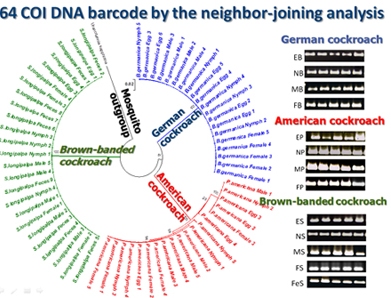Technology for Medical Entomology
DNA barcodes: Barcodes of life
The innovative method for identifying species using a standardized DNA sequences. DNA barcoding has proved to be useful in several applications such as collection of museum specimens, biodiversity, epidemiology and vector control.
Link:
http://www.boldsystems.org
http://ibol.org
http://barcoding.si.edu
http://www.ecbol.org
http://www.dnabarcodes.org

NGS: Next generation sequencing
Next-generation sequencing technologies are revolutionizing genomics and their effects are becoming increasingly widespread. The newer technologies constitute various strategies that rely on a combination of template preparation, sequencing and imaging, and genome alignment and assembly methods. The high demand for low-cost sequencing has driven the development of high-throughput sequencing (or next-generation sequencing) technologies that parallelize the sequencing process, producing thousands or millions of sequences at once. This application can be used to study phenomena such as: Whole genome sequencing, metagenomics, gene expres-sion changes, alternative splicing events, allele specific gene expression, chimeric transcripts (including gene fusion events), novel transcripts and RNA editing. Next generation sequencing platforms are producing biological sequencing data in unprecedented amounts. National Center for Biotechnology Information (NCBI), the European Bioinformatics Institute (EBI), and the DNA Data Bank of Japan (DDBJ), have established the Sequence Read Archive (SRA) to pro-vide the scientific community with an archival destination for next generation data sets.
Like to the SRA is now accessible at:
http://www.ncbi.nlm.nih.gov/Traces/sra from NCBI
http://www.ebi.ac.uk/ena from EBI
http://www.ddbj.nig.ac.jp/sub/trace_sra-e.html from DDBJ
Users of these resources can obtain data sets deposited in any of the three SRA instances. Links and submission instructions are provided

LAMP
Loop-Mediated isothermal amplication (LAMP) is a simple, rapid and specific DNA amplification method. It used 4 different primers that designed to recognize 6 distinct regions on the target gene. The LAMP reaction was performed at constant temperature by simple incubator or water bath at 63-65 degree for 30-60 minutes. LAMP was applied to detection of pathogens (virus, protozoa, helminthes) in mosquitoes, identification of mosquitoes species etc.
Link: http://loopamp.eiken.co.jp/e/lamp/index.html
MICRO/NANOCAPSULE FOR DEVELOPING MOSQUITO REPELLENT:
Essential oils is easily oxidized and vaporized cause it unsuitable to kept for long term use so new form of mosquito repellent product should be developed. By using encapsulation technique to prepare essential oil in microcapsule, capsule shell can enhance stability of essential oil such as protection from the oxidization or labile of active ingredients and also can control releasing rate of active volatile compound.

